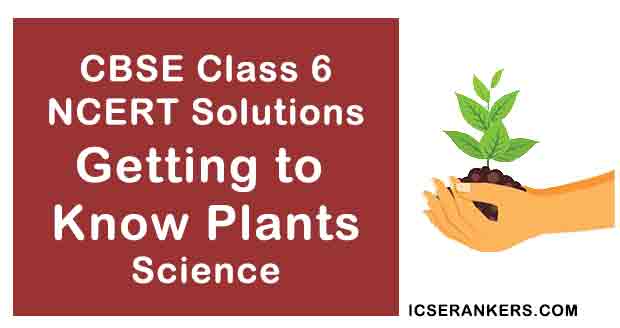NCERT Solutions for Chapter 7 Getting to Know Plants Class 6 Science
Short Notes for Class 6 Science Chapter 7 Getting to Know Plants
Plants are usually grouped into herbs, shrubs and trees based on their height, nature of stem and branches. The stem bears leaves, flowers and fruits. Leaf usually has a petiole and lamina. The pattern of veins on the leaf is called venation. It can be reticulate or parallel. Leaves give out water vapour through the process of transpiration. Green leaves make their food by the process of photosynthesis using carbon dioxide and water in the presence of sunlight. Roots absorb water and minerals from the soil. They also anchor the plant firmly in the soil. Roots are mainly of two types: tap root and fibrous root. Plants having leaves with reticulate venation have tap roots while plants having leaves with parallel venation have fibrous roots. The stem conducts water from roots to the leaves (and other parts) and food from leaves to other parts of the plant. The parts of a flower are sepals, petals, stamens and pistil.

Chapter Name | Getting to Know Plants NCERT Solutions |
Class | CBSE Class 6 |
Textbook Name | Science |
Related Readings |
|
Question 1: Correct the following statements and rewrite them in your notebook.
(a) Stem absorbs water and minerals from the soil.
(b) Leaves hold the plant upright.
(c) Roots conduct water to the leaves.
(d) The number of petals and sepals in a flower is always equal.
(e) If the sepals of a flower are joined together, its petals are also joined together.
(f) If the petals of a flower are joined together, then the pistil is joined to the petal.
Answer
(a) Roots absorbs water and minerals from the soil.
(b) Stem hold the plant upright.
(c) Stem conduct water to the leaves.
(d) The number of petals and sepals in a flower is not always equal.
(e) If the sepals of a flower are joined together, its petals are separate and not joined together.
(f) If the petals of a flower are joined together, then the pistil is not necessarily joined to the petal.
Question 2: Draw (a) a leaf, (b) a taproot and (c) a flower, you have studied for Table 7.3.
Answer

Question 3: Can you find a plant in your house or in your neighbourhood, which has a long but a weak stem? Write its name. In which category would you classify it?
Answer
Money Plant has a ling but weak stem. It is a climber.
Question 4: What is the function of a stem in a plant?
Answer
Functions of stem in a plant:
- It holds the branches, leaves, flowers and fruits.
- The stem transports water and minerals from roots to the upper parts.
- It also transports the prepared food from leaves to other parts.
Question 5: Which of the following leaves have reticulate venation?
Wheat, tulsi, maize, grass, coriander (dhania), China rose
Answer
Tulsi, Coriander (Dhania) and China rose.
Question 6: If a plant has fibrous root, what type of venation do its leaves likely to have?
Answer
Parallel venation.
Question 7: If a plant has leaves with reticulate venation, what kind of roots will it have?
Answer
Taproot.
Question 8: Is it possible for you to recognize the leaves without seeing them? How?
Answer
Yes. We can identify the type of leaves by looking at its roots. Plants having leaves with reticulate venation have tap roots while plants having leaves with parallel venation have fibrous roots.
Question 9: Write the names of the parts of a flower.
Answer
The parts of a flower are sepals, petals, stamens and pistil.
Question 10: Which of the following plants have you seen? Of those that you have seen, which one have flowers?
Grass, maize, wheat, chilli, tomato, tulsi, pipal, shisham, banyan, mango, jamun, guava, pomegranate, papaya, banana, lemon, sugarcane, potato, groundnut
Answer
We have seen the following plants:
- Grass, maize, wheat, chilli, tomato, tulsi, pipal, banyan, mango, jamun, guava, papaya, banana, lemon, sugarcane, potato.
Plants having flowers:
- Maize, wheat, chilli, tomato, tulsi, pipal, shisham, banyan, mango, jamun, guava, pomegranate, papaya, banana, lemon, potato.
Question 11: Name the part of the plant which produces its food. Name this process.
Answer
Leaves produce food for plant with the process of photosynthesis.
Question 12: In which part of a flower, you are likely to find the ovary?
Answer
Ovary is located in the lowermost and swollen part of the pistil of flower.
Question 13: Name two flowers, each with joined and separated sepals.
Answer
Plants with joined sepals: Datura and Tomato flower.
Plants with separated sepals: Lotus and Rose.
